Countdown as SpaceX, NASA prepare to test new astronaut capsule

NASA and SpaceX were counting down the hours Friday to the launch of a new astronaut capsule.
CAPE CANAVERAL (AFP) - NASA and SpaceX were counting down the hours Friday to the launch of a new astronaut capsule on a week-long return flight to the International Space Station, a key step towards resuming manned space flights from US soil after an eight-year break.
This time around, the only occupant will be a dummy named Ripley. But if the test goes smoothly, NASA plans to put two astronauts on board SpaceX s Crew Dragon capsule by the end of the year.
The new capsule will blast off on board a rocket built by SpaceX -- the space company of billionaire Elon Musk -- at 0249 (0749 GMT) on Saturday from the Kennedy Space Center at Cape Canaveral, Florida.
It is scheduled to reach the ISS by Sunday, with a return to Earth next Friday.
The excitement was palpable at Cape Canaveral, from the space-fan volunteers guiding media on site, to the tourists come to watch the launch light up the Florida coastline, to the Kennedy Space Center s director, former astronaut Bob Cabana.
"It s been a long eight years," Cabana said, as SpaceX employees milled around the rocket, staged vertically on the legendary launch pad where the Apollo Moon missions took off.
"It s exciting to see a crewed vehicle, the SpaceX Dragon, up there on a Falcon 9 on pad 39A," said Cabana, who witnessed the last space shuttle flight return to Cape Canaveral on July 21, 2011.
The sky over the launch site was clear Friday, with meteorologists saying there was an 80 percent chance of conditions being favorable overnight.
After the shuttle program was shuttered in 2011 after a 30-year run, NASA began outsourcing the logistics of its space missions.
It pays Russia to get its people up to the ISS orbiting research facility at a cost of $82 million a head, for a round trip.
In 2014, the US space agency awarded contracts to SpaceX and Boeing for them to take over this task.
But the program has suffered delays as safety requirements are much more stringent for manned flights than for unmanned missions to deploy satellites.
"When you re here, right, there s a pride in the country. It s different," said Mark Geyer, director of the Johnson Space Center, where US astronauts are based. "There s a pride in what the United States and its teams can accomplish."
Boeing also received a contract in 2014 to develop a space vessel, the Starliner. It will not be tested until April, in a mission similar to SpaceX s.
NASA did not want to rely on just one single vehicle, in case of accidents.
Planning has been delayed by around three years, with the first manned SpaceX flight still penciled in for July, though officials frequently refer to the end of 2019 as a more realistic deadline.
Saturday s flight aims to test the vessel s reliability and safety in real-life conditions.
The dummy that will ride in the capsule -- which SpaceX s Hans Koenigsmann prefers to call a "smartie" -- has been nicknamed Ripley in honor of the character played by Sigourney Weaver in the "Alien" movies.
It will be fitted with monitors to test the forces that future astronauts will be subjected to on take-off and when they return to the Earth s atmosphere and then splash down in the Atlantic, slowed down by giant parachutes.
Everything will have to function according to a strict plan: the separation of the capsule and the rocket, the 27 hours orbiting towards the space station and then docking with it.
"We instrumented the crap out of that vehicle," said Kathy Lueders, the manager of NASA s Commercial Crew program. "We re going to learn a ton from this mission."
For SpaceX, which Musk founded in 2002, sending an astronaut into orbit would be a culmination of years of hard work and high-risk investment.
"Every mission is important, but this is even more important, said Koenigsmann, the firm s vice-president for build and flight reliability.
"Early on, our goal was human spaceflight," he said. "Human spaceflight is a core value of business of SpaceX."
In less than a decade, SpaceX has become a key partner for NASA, in addition to dominating the market for private satellite launches.
Its Falcon 9 rockets have resupplied the space station 15 times in seven years, even though one of them blew up in 2015.


